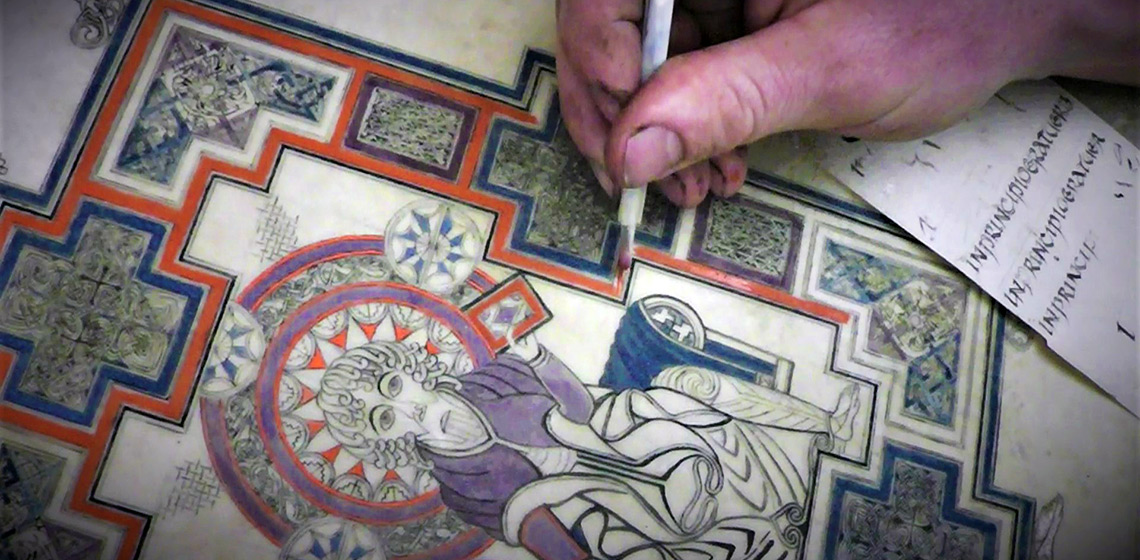The content is published under a Creative Commons Attribution Non-Commercial 4.0 License.
Unreviewed Mixed Matters Article:
Making the Book of Kells

This article gives a brief history of the context of the Book of Kells before summarising recent research into its material makeup. It then goes on to introduce a possible site of production that has been excavated in the Scottish Highlands, before introducing a project to recreate a folio from the manuscript as an experimental archaeology project.
The Book of Kells is perhaps the world’s most famous relic, it has been handed down through the generations as a venerated artefact for almost a millennium without interruption. Its first appearance in the historic record and only known period of absence from Irish society occurred in 1007, by which time it was already an ancient artefact. It had been stolen from the church at Kells and was missing for ‘two months and twenty nights’ according to the annals of Ulster, which goes on to describe the manuscript as ‘the most precious object of the western world’. The Book remained at Kells into the 17th century, by which time the powerful Columban abbey had become a near derelict parish church, badly damaged in the 1641 Irish rebellion. It was transferred to Dublin for safety, and under the direction of the Bishop of Meath Henry Jones, a leading figure in Cromwell’s army, the Catholic relic was presented to Trinity College where it remains today.
A thousand years’ worth of historical sources for an artefact would normally be a gift for any archaeologist, but in the case of Kells, basic questions still aren’t answered. We don’t know when it was made, where, or even how. There is no other object of comparable complexity, no existing craft process that matches the detail, not even a lexicon for many of the toolmarks and processes that can be identified. But there has been a wealth of research and new discoveries over recent years, that now make it possible to identify most of the material components and go into detail on some of the craft processes involved.
Between 2004 and 2006, micro-Raman spectroscopy was used to analyse the book’s pigments. It gave an almost complete list of ingredients, some of which contradicted earlier analysis. There were all the usual suspects for a medieval manuscript, including red lead, Verdigris and orpiment. However, the blue, which had previously been identified as the mineral Lapis Lazuli, turned out to be woad. In 2007, the organic purple was identified as orcein through the use of a fluorometer, measuring luminescence lifetime decay. Another unexpected result, as purple ink in manuscripts is often associated with that derived from the murex shellfish.
While this research was being carried out in Dublin, an entirely unrelated archaeological excavation was underway in the village of Portmahomack in the Scottish Highlands. Initially investigating a promising boundary ditch, it soon became clear that the site was a major Pictish monastery. Eventually the complex site workshop enclosure, with pits, bone pegs and curved blades was deciphered; it was a parchmanarie, a vellum workshop. This isn’t just unusual, it is unique, and it had a few lessons in store for the modern parchment maker. They did not use lime to soak the hides, but they burned seaweed instead. Also, the lunellum, the curved blade used to scrape the hide, was much smaller than a modern equivalent. This is because they were using hot water to strip the grain layer from the hide, a much more efficient method than brute force alone.
There was also a metal working area with evidence of craftsmanship of the highest quality, including a metal boss thought to be made by the same craftsman that produced another Irish treasure, the silver Derrynaflan Paten. A stylus and a book clasp were also recovered, as well as fragments of high quality Pictish sculpture, including one with a written inscription. You could not hope for a better range of finds to support the theory that a manuscript of Kells’ quality could have been made at this site. One more crucial detail emerged later, once all the post holes and structures had been documented. The entire site was laid out geometrically, some of it even in the Fibonacci sequence; these craftsmen shared the same obsession with geometric detail as found in the great insular gospel books.
Archaeologists and scientists have provided great insight into the materials and methods of the Book of Kells’ construction in recent years. Enough, I believe, for it to be taken up as an experimental archaeology project. This is the plan: I am aiming to reconstruct folio 27v, an image of the four evangelists’ symbols within an ornate border. It contains all of the pigments and most of the decorative features representative of the book as a whole. If it was an excavation, this is where you would put a trench. The parchment will be made to the specifications suggested by the evidence from Portmahomack, and I will aim to source all of the raw materials within the locality. So, growing woad, collecting lichen, cooking lead carbonate, and so on. The design will be created from first principles by working out the geometric ratios employed by the original artist. I will attempt to relate each design feature to an artefact with better context and provenance than Kells, with Pictish sculpture being a major source.
This project will be carried out in collaboration with the Tarbat Discovery Centre, custodians of the site at Portmahomack. We are going to run it as a crowdfunding project through Kickstarter and, if successful, the results will be exhibited in the centre. The pigments produced will be analysed by Team Pigment at Durham University and experts will be consulted at each stage of the process, from the parchment making through to theological implications. You can follow the project launch page here.
https://www.kickstarter.com/projects/scribalstyles/making-the-book-of-kells
Keywords
Country
- Ireland

